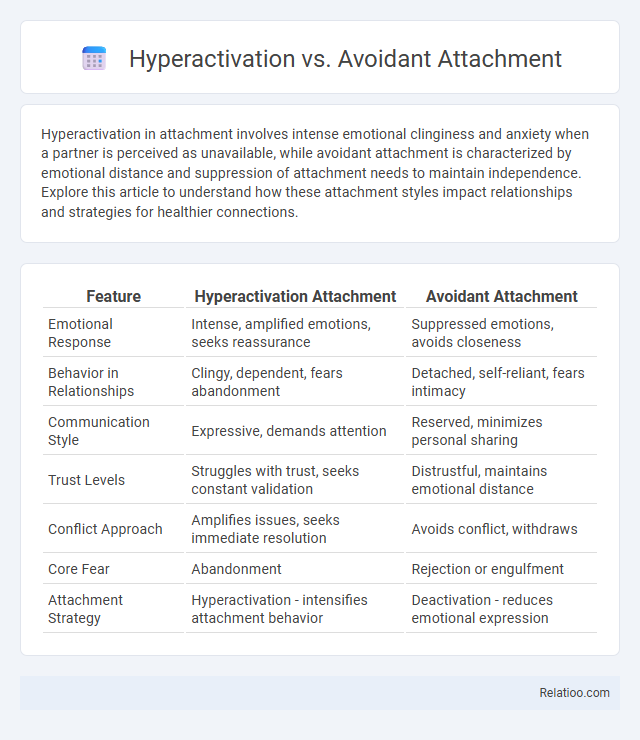Hyperactivation in attachment involves intense emotional clinginess and anxiety when a partner is perceived as unavailable, while avoidant attachment is characterized by emotional distance and suppression of attachment needs to maintain independence. Explore this article to understand how these attachment styles impact relationships and strategies for healthier connections.
Table of Comparison
| Feature | Hyperactivation Attachment | Avoidant Attachment |
|---|---|---|
| Emotional Response | Intense, amplified emotions, seeks reassurance | Suppressed emotions, avoids closeness |
| Behavior in Relationships | Clingy, dependent, fears abandonment | Detached, self-reliant, fears intimacy |
| Communication Style | Expressive, demands attention | Reserved, minimizes personal sharing |
| Trust Levels | Struggles with trust, seeks constant validation | Distrustful, maintains emotional distance |
| Conflict Approach | Amplifies issues, seeks immediate resolution | Avoids conflict, withdraws |
| Core Fear | Abandonment | Rejection or engulfment |
| Attachment Strategy | Hyperactivation - intensifies attachment behavior | Deactivation - reduces emotional expression |
Understanding Attachment Styles: An Overview
Understanding attachment styles involves recognizing that hyperactivation triggers intense emotional responses and a constant need for closeness, whereas avoidant attachment suppresses emotional expression and promotes independence. Your relationships are influenced by these patterns, which shape how you seek comfort and handle intimacy. Differentiating between hyperactivation, characterized by anxiety and urgency, and avoidant attachment, defined by emotional distance and self-reliance, is key to improving interpersonal dynamics.
Defining Hyperactivation in Attachment
Hyperactivation in attachment refers to an intense emotional strategy where individuals amplify their attachment needs and worries to gain reassurance and closeness from others, often manifesting as clinginess or heightened anxiety. It contrasts with avoidant attachment, which involves emotional suppression and distancing behaviors to minimize attachment needs and maintain independence. Understanding hyperactivation is crucial for recognizing patterns of dependency and emotional dysregulation in relationships.
Exploring Avoidant Attachment Patterns
Avoidant attachment patterns often manifest through emotional distancing and reluctance to seek support, contrasting with hyperactivation's intense emotional expression and clinging behaviors. Understanding your avoidant attachment style can help identify how you suppress vulnerability to maintain independence, impacting relationships negatively. Recognizing these patterns allows for healthier emotional regulation and improved connection with others by addressing underlying fears of intimacy and rejection.
Key Differences: Hyperactivation vs Avoidant Attachment
Hyperactivation attachment is characterized by intense emotional expression and hypervigilance toward relational threats, often leading to clinginess and anxiety. Avoidant attachment involves emotional suppression and a tendency to distance oneself from others to maintain independence and avoid vulnerability. The key difference lies in hyperactivation driving approach and seeking reassurance, while avoidance promotes withdrawal and emotional disengagement.
Origins and Development of Attachment Behaviors
Hyperactivation in attachment behavior originates from inconsistent caregiver responses, leading individuals to amplify their emotional expressions to gain attention and reassurance. Avoidant attachment develops when caregivers are consistently unresponsive or rejecting, causing individuals to suppress emotional needs and minimize dependency to protect themselves from rejection. These attachment patterns form through early interactions that shape neural pathways influencing emotional regulation, stress response, and interpersonal expectations.
Emotional Responses in Hyperactivation and Avoidant Styles
Hyperactivation in attachment triggers intense emotional responses such as heightened anxiety, fear of abandonment, and persistent craving for closeness, causing You to become overly sensitive to perceived relational threats. In contrast, avoidant attachment suppresses emotional expression and prioritizes self-reliance, which minimizes visible distress but often leads to emotional detachment and difficulty in forming deep connections. Understanding these distinct emotional reactions helps in recognizing how Your relational strategies manifest during stress and intimacy challenges.
Impact on Relationships and Communication
Hyperactivation in attachment drives intense emotional expression and neediness, often overwhelming partners and impairing effective communication. Avoidant attachment prompts emotional distancing and suppression, creating barriers to intimacy and reducing responsiveness to your partner's needs. These contrasting patterns influence relationship dynamics by shaping how individuals seek closeness or manage conflict, impacting trust, empathy, and overall relational satisfaction.
Common Triggers for Hyperactivation and Avoidance
Common triggers for hyperactivation attachment include perceived threats of abandonment, emotional neglect, or inconsistent caregiving, which provoke intense anxiety and efforts to seek closeness. Avoidant attachment is often triggered by emotional unavailability, rejection, or criticism, leading individuals to suppress attachment needs and increase emotional distance. Both hyperactivation and avoidance emerge from early attachment disruptions but manifest as opposing responses to similar relational stressors.
Healing and Managing Insecure Attachment Styles
Healing and managing insecure attachment styles like hyperactivation and avoidant attachment requires understanding their emotional triggers and coping mechanisms. Hyperactivation often leads to heightened emotional expression and anxiety, whereas avoidance promotes emotional suppression and distancing. You can foster secure attachment by practicing mindfulness, building emotional regulation skills, and seeking therapeutic support tailored to your specific attachment patterns.
Building Secure Attachment: Strategies for Change
Building secure attachment involves recognizing patterns of hyperactivation, characterized by heightened emotional sensitivity and anxiety, as well as avoidant attachment marked by emotional distancing and suppression. Effective strategies include consistent emotional responsiveness, fostering open communication, and creating safe relational environments that encourage trust and vulnerability. Therapeutic approaches such as emotion-focused therapy and mindfulness practices help individuals regulate hyperactivation and reduce avoidance, promoting balanced, secure connections.

Infographic: Hyperactivation vs Avoidant Attachment
 relatioo.com
relatioo.com